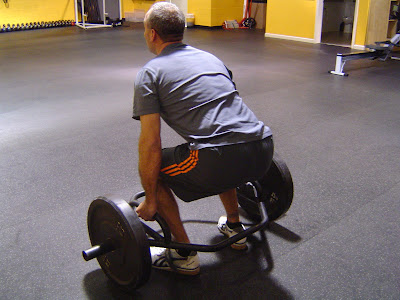A Cool Tool for Your Box
 This is J. He's a firefighter/paramedic from Crossfit St. Charles who is working with me on the lifts. Like many dudes, J has some flexibility issues that impair his ability to get into optimal lifting positions. He's got some ankle and IT band issues that affect his lower extremity position with lift off in the clean, as well as some hamstring and thoracic spine issues. The hamstrings are stiff and make it hard for J to hinge at the hips. His thoracic spine and shoulders are a bit forward from years of wearing heavy gear from his job; this isn't a fixed deformity yet, but it's getting close.
This is J. He's a firefighter/paramedic from Crossfit St. Charles who is working with me on the lifts. Like many dudes, J has some flexibility issues that impair his ability to get into optimal lifting positions. He's got some ankle and IT band issues that affect his lower extremity position with lift off in the clean, as well as some hamstring and thoracic spine issues. The hamstrings are stiff and make it hard for J to hinge at the hips. His thoracic spine and shoulders are a bit forward from years of wearing heavy gear from his job; this isn't a fixed deformity yet, but it's getting close.When he lifts with a barbell (hands in front, pronated grip), stiff hammies combined with the forward-tending t-spine make it tough for J to get into a start position with good neutral thoracic and lumbar spine. All forward bending movement is initiated with flexion of the torso and t-spine, not with a flexion (hinging) at the hip. He cannot do a Waiter's Bow movement properly without a dowel along his back to give constant feedback.
How do we change the movement pattern and affect the corresponding tissue so he can get a better lift off position?
We put him on the high handle position of the Hexlite bar. This neutral hand position facilitates extension in the t-spine in the bottom position; the high handle position is just high enough so the hamstring length is challenged, but does not restrict the pelvis and cause lumbar spine flexion. I cue J to keep his butt down, chest up, shoulders back and push the weight away from the floor, not pull. He feels what it is like to use his legs with combined ankle/knee/hip extension movement vs. a hip extension dominant movement. He feels what it is like to "set" his back in a strong, efficient lift off position.
We supplement this work with Waiter's Bow drills, supine and wall-based arm slides and bodyweight squats with the hands behind the head, not in front of the body. Each drill is mindful and methodical--especially the squats and the Waiter's bow. We have to tease out the t-spine leading the hip and make the hip and pelvis lead the torso.
We progress with the low handle of the Hexlite bar and work in the barbell using the blocks to gradually lower the bar to the floor--a top-down and whole/part/whole approach.

Comments